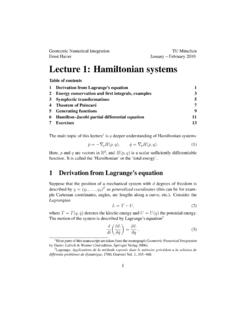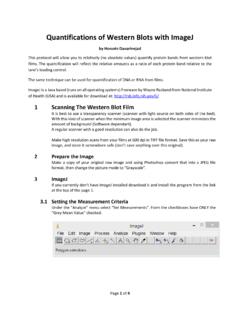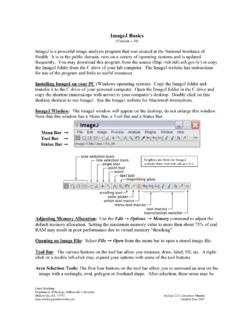Transcription of Two Ways to Count Cells with ImageJ - UNIGE
1 Two ways to Count Cells with ImageJ . Figuring out how many Cells are in an image is a common need in image analysis. There are several ways to go about this, some more involved than others. These instructions cover two very basic ways to get cell counts, one manual and one automated. The automated version also allows other information about each cell, such as pixel intensity, area and/or diameter, to be read out at the same time. Manual Cell Counting and Marking (plugin required). This set of instructions allows you to Count Cells by clicking in the cell image.
2 Each click marks the cell with a colored square and adds the cell to a tally sheet. You can mark up to four different groups of Cells , and each group is tallied separately and marked with a different color square. 1) First, you must install the Cell Counter plugin, which is available on the microscopy server under ~ ImageJ plugins 1 analysis. To install the plugin, copy the entire 1. analysis folder into the plugins folder within the ImageJ folder on your computer. You must re-start ImageJ after plugin installation for the 1 analysis folder containing the Cell Counter plugin to appear under the Plugins menu.
3 2) Open the image you want to Count . Cell counter only works on single images, not stacks. You can use Image . Stacks Stack to Images to convert a .tiff stack or .stk to single .tif files. It does not matter if the image is greyscale, single color or multiple colors. However, if your image is in greyscale (you can tell because it will say 8-bit or 16-bit at the top, ours is a color image, so it says RGB ) and you want your clicked squares to be in color, you must convert the image to an RGB. color image with Image Type RGB color. Greyscale images are supported by the counter plugin, but the squares are white or black, so difficult to distinguish between types.
4 3) Select Plugins 1 analysis Cell Counter (or Plugins Cell Counter). Two new windows will open, a counter window with your image on top of a row of buttons, and a results window where Cells will tally. 4) To begin counting, click one of the buttons at the bottom of the counter window. Then click directly on a cell/object you wish to Count . A white square will be Created by Christine Labno University of Chicago Integrated Light Microscopy Core Page 1 of 5. left behind on the object, and a tally will start in the results window. If you click on an object by mistake, you can undo it by selecting Edit Undo.
5 You must undo right away, you cannot undo more than one object in a row. To change the type of cell counted, click another button at the bottom. Type 1 = white, type 2 = green, type 3 =. blue and type 4 = yellow markers. In this example we distinguish between nuclei inside the green area (type 4, yellow markers) and outside the green area (type 1, white marks). You can switch back and forth between types at any time, the tally will keep track. Cells may be counted as more than one type. Use Results Save as to save your counts as Excel formatted files.
6 5) If you are not seeing the marker squares in color, you will need to make your image an RGB image. To do this, close Cell Counter by closing the image window. Open your image again and use Image Type RGB color. It's okay if your image is still greyscale. Now when you open the image in Cell Counter and click for a marker, the markers will be in color. If you have just clicked type 1 and see it is white, DON'T. PANIC. Remember the type 1 marker is supposed to be white. May I suggest trying type 2? 6) When you are finished counting, click the Results button.
7 You will get a total for each cell type plus a grand total of all clicks at the bottom of the Results window. The results log can be copied and pasted and/or saved as .xls Excel spreadsheet. Unfortunately, the only way we know of to save the image with the marks is to create a screenshot (Print screen), open this in ImageJ with File New System Clipboard (Cntl + Shift + V) and save this as a .tif or .jpg file. This is essentially a snapshot of the image plus marks, it cannot be altered. Automated Counting of Single Color Images (no plugin required).
8 Sometimes counting by hand is just not practical, such as when there are many Cells per image or you have many images to process. Counting can be automated, although depending on your image, this can get to be a complicated process. The example below details a simple Count from a single color fluorescence image. For more complicated counts (multi-color images, counts from histology or brightfield image, counting Cells within a region, etc.) the Microscopy Core Facility staff can help you develop a custom counting routine or macro. 1) Open the image to be counted.
9 If it is a color image (RGB), as in our example above, it will have to be converted to greyscale before proceeding. Check that you have set Edit . Options Conversions to scale when converting. Then use Image Type 16-bit to convert to greyscale. Created by Christine Labno University of Chicago Integrated Light Microscopy Core Page 2 of 5. 2) Once the image is in greyscale (8-bit or 16-bit) use Image Adjust Threshold (Cntl + Shift + T) to highlight all of the structures you want to Count . To highlight, either use the sliders or use the set . button to type in a known range of pixel intensities (if you want to threshold a whole set of images the same way, for instance).
10 Some particles may be touching already, shown here, or they may run together during the threshold. This is somewhat fixable. Process . Subtract background with rolling ball may help if you find you are highlighting too many noise or background pixels. Once you have the area highlighted as well as you can, click apply. This will create a binary version of the image with only two pixel intensities: black = 0 and white = 255. 3) If you have particles that have merged together, Process Binary Watershed can often (but not always) accurately cut them apart by adding a 1 pixel thick line where it feels the division should be.

















